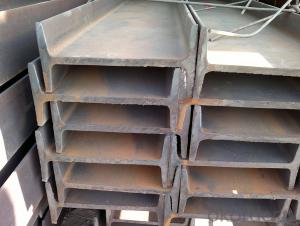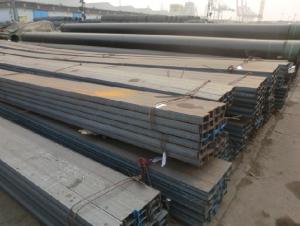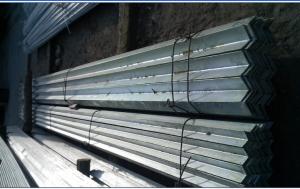IPE
- Loading Port:
- China Main Port
- Payment Terms:
- TT OR LC
- Min Order Qty:
- -
- Supply Capability:
- -
OKorder Service Pledge
OKorder Financial Service
You Might Also Like
Product Description:
IPE Beam Details:
| Minimum Order Quantity: | 10MT | Unit: | m.t. | Loading Port: | Tianjin Port, China |
| Supply Ability: | 10000MT | Payment Terms: | TT or LC |
Product Description:
Specifications of IPE Beam
1. Invoicing on theoretical weight or actual weight as customer request
2. Standard: EN10025, GB Standard, ASTM
3. Grade: Q235B, Q345B, SS400, ASTM A36, S235JR, S275JR
4. Length: 5.8M, 6M, 9M, 12M as following table
5. Sizes: 80mm-270mm
Dimensions(mm) | |||||
h | b | s | t | Mass Kg/m | |
IPE80 | 80 | 46 | 3.80 | 5.20 | 6.00 |
IPE100 | 100 | 55 | 4.10 | 5.70 | 8.10 |
IPE120 | 120 | 64 | 4.80 | 6.30 | 10.40 |
IPE140 | 140 | 73 | 4.70 | 6.90 | 12.90 |
IPE160 | 160 | 82 | 5.00 | 7.40 | 15.80 |
IPE180 | 180 | 91 | 5.30 | 8.00 | 18.80 |
IPE200 | 200 | 100 | 5.60 | 8.50 | 22.40 |
IPE220 | 220 | 110 | 5.90 | 9.20 | 26.20 |
IPE240 | 240 | 120 | 6.20 | 9.80 | 30.70 |
IPE270 | 270 | 135 | 6.60 | 10.20 | 36.10 |
Appications of IPE Beam
1. Supporting members, most commonly in the house raising industry to strengthen timber bears under houses. Transmission line towers, etc
2. Prefabricated structure
3. Medium scale bridges
4. It is widely used in various building structures and engineering structures such as roof beams, bridges, transmission towers, hoisting machinery and transport machinery, ships, industrial furnaces, reaction tower, container frame and warehouse etc.
Package & Delivery of IPE Beam
1. Packing: it is nude packed in bundles by steel wire rod
2. Bundle weight: not more than 3.5MT for bulk vessel; less than 3 MT for container load
3. Marks: Color marking: There will be color marking on both end of the bundle for the cargo delivered by bulk vessel. That makes it easily to distinguish at the destination port.
4. Tag mark: there will be tag mark tied up on the bundles. The information usually including supplier logo and name, product name, made in China, shipping marks and other information request by the customer.
If loading by container the marking is not needed, but we will prepare it as customer request.
5. Transportation: the goods are delivered by truck from mill to loading port, the maximum quantity can be loaded is around 40MTs by each truck. If the order quantity cannot reach the full truck loaded, the transportation cost per ton will be little higher than full load.
6. Delivery of IPE Beam: 30 days after getting L/C Original at sight or T/T in advance
Production flow of IPE Beam
Material prepare (billet) —heat up—rough rolling—precision rolling—cooling—packing—storage and transportation
- Q:How do steel I-beams perform in terms of fire spread prevention?
- Steel I-beams have proven to be highly effective in preventing the spread of fire. This is because steel beams are non-combustible and do not contribute to the combustion process, making them resistant to fire. In the event of a fire, steel I-beams maintain their structural integrity for a longer period of time compared to materials like wood or concrete. This provides increased time for evacuation and firefighting efforts. Furthermore, steel has a high melting point, which adds to its fire resistance. Although steel can lose its strength in high temperatures, it does not burn or release toxic gases, making it a dependable choice for preventing fire spread. However, it is important to consider factors such as the thickness of the steel, fire intensity, and duration of the fire, as these can affect the fire-resistant properties of steel I-beams. Therefore, it is crucial to incorporate fire protection systems and coatings to further enhance the fire resistance of steel structures.
- Q:Are there any limitations or restrictions on the use of steel I-beams?
- Yes, there are certain limitations and restrictions on the use of steel I-beams. These limitations are primarily related to the structural capacity, design considerations, and safety requirements. Firstly, the size and shape of steel I-beams are limited by manufacturing processes and industry standards. I-beams come in various sizes and dimensions, and their selection depends on the load-bearing requirements of the structure. Using an I-beam that does not meet the required specifications can compromise the structural integrity and put the safety of the building at risk. Additionally, steel I-beams have limitations in terms of their span or length. Longer spans require larger and stronger I-beams to ensure sufficient load-bearing capacity. It is essential to consult structural engineers and adhere to building codes and standards to determine the appropriate size and spacing of I-beams for a specific application. Moreover, the use of steel I-beams may be limited in certain environments. Steel can corrode when exposed to moisture or chemicals, which can weaken the beams over time. In such cases, appropriate protective coatings or corrosion-resistant materials should be used to ensure the durability and longevity of the I-beams. Lastly, there may be restrictions on the use of steel I-beams in certain building codes or regulations. These codes often dictate the minimum requirements for structural elements, fire resistance, seismic performance, and other safety considerations. It is crucial to comply with these regulations to ensure the structural stability and safety of the building. In summary, while steel I-beams offer excellent load-bearing capacity and versatility, their use is subject to limitations and restrictions. These include considerations related to size, span, environmental conditions, and compliance with building codes and safety regulations. Consulting with structural engineers and adhering to industry standards is essential to ensure the proper and safe utilization of steel I-beams in construction projects.
- Q:What are the different types of connections used with steel I-beams?
- There are several types of connections used with steel I-beams, including welded connections, bolted connections, and pinned connections. Welded connections involve joining the I-beams using a welding process, creating a strong and permanent connection. Bolted connections use bolts and nuts to secure the beams together, providing a sturdy and easily adjustable connection. Pinned connections involve using pins or bolts placed through holes in the beams, allowing for rotational movement at the connection point while still maintaining support.
- Q:What are the different types of steel finishes for I-beams?
- There are several different types of steel finishes that can be applied to I-beams, each offering unique characteristics and benefits. Some of the most common finishes include: 1. Mill Finish: This is the most basic and common type of steel finish for I-beams. It refers to the natural surface of the steel after it has been formed and processed. Mill finish provides a smooth, slightly reflective appearance, but offers minimal protection against corrosion. 2. Hot-dip Galvanized: This finish involves immersing the I-beams in a bath of molten zinc, creating a layer of zinc coating on the surface. Galvanizing provides excellent protection against corrosion, making it ideal for outdoor applications or environments with high moisture levels. The coating can range from a shiny silver to a dull gray, depending on the thickness of the zinc layer. 3. Painted: I-beams can be painted with various types of coatings, including epoxy, enamel, or polyurethane paints. Painting not only enhances the appearance of the steel but also provides a protective barrier against corrosion. Different colors and finishes can be chosen to suit specific aesthetic or functional requirements. 4. Powder-coated: Powder coating involves applying a dry powder to the I-beam's surface and then curing it with heat, creating a durable and decorative finish. It can offer a wide range of colors and finishes, including smooth, textured, or metallic appearances. Powder coating provides excellent resistance to corrosion, impact, and fading, making it suitable for both indoor and outdoor applications. 5. Stainless Steel: I-beams can be manufactured from stainless steel, which inherently offers good resistance to corrosion. Stainless steel finishes can range from a bright, reflective surface (such as a mirror finish) to a brushed or satin finish, depending on the desired appearance and application requirements. 6. Blackened: Blackening is a chemical treatment that creates a dark, oxide layer on the surface of the steel. This finish is often chosen for aesthetic purposes, providing a unique and rustic appearance. However, it does not offer significant corrosion resistance and may require additional protective measures if used in outdoor or corrosive environments. It is important to consider the intended application, environment, and desired appearance when selecting a steel finish for I-beams. Consultation with a steel supplier or a structural engineer can help determine the most appropriate finish for your specific needs.
- Q:Are there any environmental concerns associated with using steel I-beams?
- Yes, there are environmental concerns associated with using steel I-beams. Steel production involves significant energy consumption and releases greenhouse gases, contributing to climate change. Additionally, the extraction and processing of raw materials for steel production can lead to habitat destruction, deforestation, and water pollution. However, using recycled steel or implementing sustainable manufacturing practices can mitigate some of these concerns.
- Q:Can steel I-beams be used in bridges?
- Yes, steel I-beams can be used in bridges. In fact, they are commonly used in bridge construction due to their high strength-to-weight ratio, durability, and ability to withstand heavy loads.
- Q:Can steel I-beams be fire-resistant?
- Yes, steel I-beams can be fire-resistant. They can be designed and treated with fire-resistant coatings or encased in fire-resistant materials to enhance their fire-resistance. This helps to prevent structural failure and maintain their load-bearing capacity during a fire.
- Q:How are steel I-beams protected against vandalism?
- Steel I-beams are commonly protected against vandalism through several methods. One commonly used method is the application of anti-graffiti coatings, which make it easier to remove any unwanted graffiti or paint. Additionally, security measures such as surveillance cameras, motion sensors, or fencing can be installed to deter vandals and catch them in the act. In some cases, steel I-beams can also be treated with corrosion-resistant coatings to prevent damage caused by vandalism attempts.
- Q:How do steel I-beams perform in terms of moisture resistance?
- Steel I-beams are not inherently moisture-resistant. They are primarily made of steel, which is susceptible to corrosion when exposed to moisture and oxygen over time. However, the moisture resistance of steel I-beams can be improved through the application of protective coatings or treatments. These coatings, such as galvanization or epoxy coatings, create a barrier between the steel and moisture, preventing direct contact and reducing the risk of corrosion. Additionally, proper installation and maintenance, such as ensuring proper drainage and addressing any water leaks or condensation issues, can further enhance the moisture resistance of steel I-beams.
- Q:How do engineers determine the appropriate size of steel I-beams for a specific application?
- The appropriate size of steel I-beams for a specific application is determined by engineers who carefully consider various factors. These factors include load requirements, span length, and safety standards. To begin, the engineers analyze the load requirements of the application, which encompass both the dead load and the live load. This analysis helps determine the maximum load that the steel I-beams must bear. Next, the engineers take into account the span length, which refers to the distance between the supports on which the steel I-beams will be placed. Longer spans necessitate larger beams to ensure resistance against bending and deflection. After determining the load requirements and span length, the engineers consult design codes and safety standards like the AISC Manual. These standards offer tables and formulas that aid in determining the required moment of inertia and section modulus for the given loads and span length. The engineers also consider other factors such as the type of steel material, desired structural rigidity, and additional considerations like fire resistance or vibration dampening. These considerations play a role in selecting the appropriate size and shape of the steel I-beam. To simulate and analyze the behavior of the steel I-beams under different loads and conditions, engineers often utilize CAD software and structural analysis tools. This allows them to fine-tune their selection and ensure that the chosen I-beam size meets the required safety factors, deflection limits, and other performance criteria. In conclusion, engineers determine the appropriate size of steel I-beams for a specific application by taking into account load requirements, span length, safety standards, material properties, and other factors. Through careful analysis and the use of design codes and software, engineers can confidently select the most suitable I-beam size to ensure structural integrity and safety.
1. Manufacturer Overview |
|
|---|---|
| Location | |
| Year Established | |
| Annual Output Value | |
| Main Markets | |
| Company Certifications | |
2. Manufacturer Certificates |
|
|---|---|
| a) Certification Name | |
| Range | |
| Reference | |
| Validity Period | |
3. Manufacturer Capability |
|
|---|---|
| a)Trade Capacity | |
| Nearest Port | |
| Export Percentage | |
| No.of Employees in Trade Department | |
| Language Spoken: | |
| b)Factory Information | |
| Factory Size: | |
| No. of Production Lines | |
| Contract Manufacturing | |
| Product Price Range | |
Send your message to us
IPE
- Loading Port:
- China Main Port
- Payment Terms:
- TT OR LC
- Min Order Qty:
- -
- Supply Capability:
- -
OKorder Service Pledge
OKorder Financial Service
Similar products
New products
Hot products
Related keywords





























